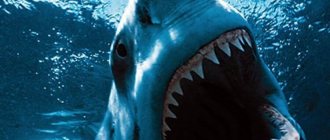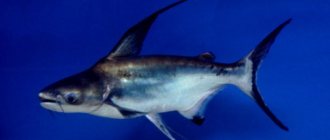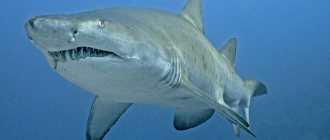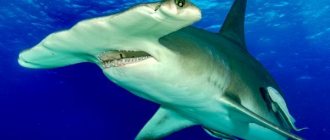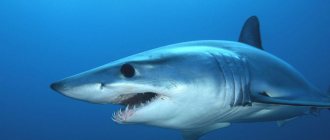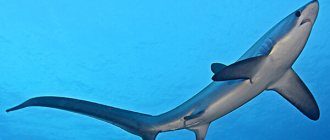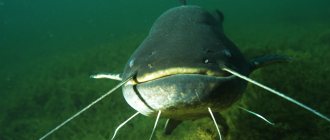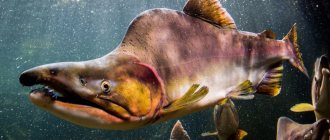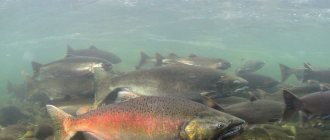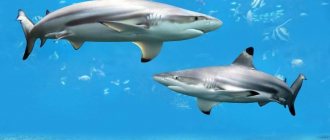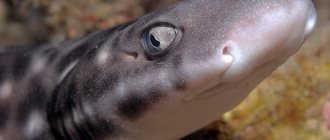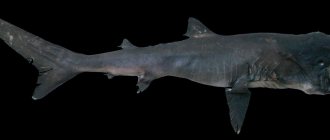The ocean is home to many amazing creatures, and among them the sticky fish, which has unique abilities, occupies a worthy place. As you will see later, it is not named this way at all by chance, because this creature spends most of its life attached to the body of some sea creature. And quite often this object of “affection” turns out to be a shark. How little riders get along with their bloodthirsty “transport”, and what can connect them, we will discuss in the article.
What do sticky fish look like and where do they live?
Stuck is a small thirty-centimeter fish, which, however, sometimes grows up to 100 cm. It is a relative of horse mackerel, has a brownish, yellowish or gray-blue color, a large mouth strewn with small teeth, and a slightly protruding lower jaw.
The shape of the fish indicates that this is a fast and active Cuman - it has a narrow body flattened laterally and a flattened head. But it’s just that Sticky doesn’t really like to swim. And the upper fin, transformed into a suction disk, helps it avoid this vital necessity. With the help of this device, surrounded by a muscle roller, the fish can attach itself to sharks, stingrays, turtles and other marine life, without bothering itself with long swims.
The sticky fish inhabits mainly tropical and subtropical waters, but it is also found in temperate latitudes. In total, researchers know of 7 species of this fish, including the shark remora, so named for its special affinity for sharks. By the way, it is sometimes found even in the Far East in the Peter the Great Gulf.
Sexual dimorphism of Ancistrus
Quite clear sex differences are observed in ancistrus from approximately 12-15 months of age. Females, as a rule, are larger, longer and slimmer than males, their bodies are taller, and their fins are longer and sharper.
One should especially note a detail characteristic only of males - on the head around the upper jaw there are skin growths arranged in pairs (“whiskers”), which in older individuals reach one and a half to two centimeters and even branch. In females, the processes are poorly developed throughout their lives and are almost invisible.
The male is hiding from me so that I don’t take a picture of him for the blog. How did I know, catfish
Ancistrus are superior to all herbivorous fish in their ability to eat algae; in addition, they eat the remains of animal and plant food that are not eaten by other fish. If there is a lack of algae fouling, aquarium plants can be eaten, especially tender young leaves, in which holes are successfully gnawed, and sometimes they are eaten entirely.
To avoid this, it is recommended to feed ancistrus with various plant foods. The easiest way is to use various branded foods with plant ingredients. You can also use for these purposes boiled lettuce leaves (just dip them in boiling water for one minute), cabbage or nettles, to which a weight is then tied and dropped to the bottom.
We suggest you read: What do turkeys eat? Grass for turkeys
Fish that stops ships
In search of future transport, stickies are very persistent - there are cases when they literally chased scuba divers, trying to hang on their bodies. And some species of these fish even like to travel, attached to sea vessels.
By the way, the ancient Greeks called them “fish that delay ships.” And it is no coincidence - the sticky fish, it turns out, is to blame for the fact that because of it the ships of Mark Antony and Caligula were late in sailing, which led to the battles that were lost in their time.
But nothing can be done! The sticky fish does not have a swim bladder, and therefore diving into the depths of water and moving through its thickness is difficult for it. In the process of evolution, this species greatly facilitated not only its movement, but at the same time its ability to feed.
Kraken - appearance and habits of a sea monster
There are two main versions of describing the appearance of this monster. According to the first, it is a giant squid, according to the second, it is an octopus. At the beginning of the 19th century, near Iceland, sailors saw a giant glowing jellyfish, which was also called the kraken. If you believe the entry in the ship's log, its diameter was about 70 m. However, often any large sea monster with tentacles is called a kraken. In rare cases, the kraken resembles a crab, as well as a fish, which brings to mind the legends of the remora, a giant fish with a suction cup that stopped ships.
It was only in the 19th century that the French zoologist Pierre-Denis de Montfort proposed to distinguish between two varieties of krakens. The first is a giant squid that lives in northern waters. The scientist believed that it was precisely such a kraken that Pliny described. The second species is a giant octopus that lives in the waters of the planet’s southern hemisphere.
In all legends without exception, the Kraken is attributed to large sizes. If you believe the legends, the appearance was described by the sailors who miraculously survived his attacks. Thus, the northern epic claims that the kraken’s back protrudes from the water and can be up to a kilometer in size. Its tentacles are so large that they can cover absolutely any ship. Even the largest warships could not withstand the attack of the kraken.
The size of the giant squid or octopus is so large that sailors of past centuries sometimes mistook it for an island. Stories from sailors have been preserved that describe encounters with a creature of this size. Their plots are similar - the team landed on an island that suddenly sank into sea waters. In this case, a whirlpool often formed, dragging the ship along with it. The Kraken was often blamed for the loss of ships and maritime disasters.
The Kraken doesn't break ships for fun. According to the legends, he needs fresh human flesh for food. He ate people who found themselves at sea after the destruction of the ship. Surviving a kraken attack is quite difficult. Legends describe that, like the octopus, it secretes a dark liquid. But the “ink” of the kraken, unlike that secreted by the octopus, is poisonous.
The legendary monster spends most of its time hibernating at the bottom of the sea. As a rule, at this time part of his body protrudes above the water, forcing sailors to mistake him for an island. Fishermen believed that there were always a lot of fish swimming around the kraken. If you cast a net near it, you can get a solid catch. The Bishop of Bergen explained this by saying that the kraken secretes a huge amount of nutritious excrement that attracts fish.
Shark and sticky fish: type of relationship
But it turns out that not all stickies are tightly connected to their “owners.” Some of them swim freely at the surface of the water and practically do not use a suction cup. Although most often the stickers still try to attach themselves to the body of the fish, and some even climb into its gill slits.
The shark remora, for example, cannot, according to researchers, exist at all without its large “master”. This sticky fish and the shark have formed a strong symbiosis over time, and now the remora, removed from the shark and placed in the aquarium, begins to suffocate. This important process, as it turned out, is adapted to life in a permanently attached state, when water, without much effort from the adhered fish, constantly flows to its gills, delivering the necessary amount of oxygen.
Character
Ancistrus is a fish with a peaceful, calm disposition. Catfish can be kept in a community aquarium without any problems. Such a character trait as aggression manifests itself extremely rarely. The reason for aggressive behavior is insufficient food. In this case, the catfish can start hunting for smaller fish.
Some aggression towards neighbors during the spawning period is also possible. However, this only happens if the catfish believes that something is threatening its offspring.
How does fish stick?
Sometimes sticky fish attach themselves to the shark’s belly in whole schools, which the bloodthirsty predator takes down absolutely resignedly. And, as we have already said, the oval suction cup located in the head area helps them do this.
Inside it there are fin rays that have been changed beyond recognition and now look more like blinds. When the fish goes on an independent swim, they lie flat, but if it is about to go for a ride, then it only needs to press the suction cup against a smooth surface so that they take a standing position and thus create several chambers with a partial vacuum. It is he who holds the fish on the body of the beloved “master”.
Interestingly, the stuck fish, a photo of which you can see in this article, is even capable of sliding along the surface on which it is attached. To do this, she only needs to change the position of the individual plates in her suction cup - and she can move to a more convenient place for herself.
Reproduction
The reproduction of sucker catfish is quite interesting. Pipes or long stumps are placed in a reservoir of water, in which the female lays eggs. But sometimes she produces offspring in pots and on driftwood. Despite this, the most ideal spawning substrate is a plastic pipe. To breed these fish, it is recommended to use a separate aquarium, which will protect the eggs and fry.
Throughout the spawning period, the aquarium is thoroughly cleaned and filtered. As soon as the female lays a clutch of eggs, the male takes care of the future offspring. He chases the female and, during maturation, fans the eggs with his fins. This helps oxygen reach the masonry in large quantities. The male also monitors the dead eggs and, if necessary, removes them. After about five days, small larvae are born. And the young daddy guards them for a couple of days without sailing far.
Fry
The born larvae are motionless or move, but little. They feed independently during this period from reserves deposited when the fry were eggs. After they are finished, the larvae become fry. It is from this moment that they need to be fed.
The Ancistrus fry catfish only absorbs crushed food, for example, spirulina, ground tablets. The most important thing is that the portion is small and with a minimum fraction. The fry become adults after ten months.
Does the stick always ride like a hare?
Observing the relationship between a shark and a sticky fish, the researchers discovered that they attach themselves to solitary fish in pairs. That is, as a rule, both a male and a female travel on one “host” (sometimes there are up to 6 pairs).
But their offspring initially lead a completely independent lifestyle, beginning to attach to floating objects or animals only when they reach 5-8 cm in length. To do this, as you understand, they need rather small hosts as transport - puffer fish, triggerfish, box fish, etc., from which, as they grow up, they “transition” to whales, sharks and other giants.
Keeping in an aquarium
The sticky catfish is easy to care for, but in order for it to be healthy, you will need to create the appropriate conditions:
- Tank volume . For one individual, a container of 50 liters will be enough, and for a couple – 100 liters.
- Options . The water temperature is not particularly important, but catfish are most comfortable at +17-30°C. Hardness level – from 2 to 20, acidity – from 6 to 7.5 pH.
- Water change - once a week up to ¼ of the total volume.
- Filtration and aeration . A prerequisite is the presence of a filter and an aeration system. If the catfish does not have enough oxygen, it will often rise to the surface of the water.
- The soil is pebbles of small or medium fraction.
- Plants - any, at the discretion of the aquarist.
- Lighting is moderate.
- Decoration. Driftwood and grottoes, castles and jugs should be used as decorative elements - they will serve not only as a shelter for fish that prefer to lead a secretive lifestyle. The stickers scrape food from the walls of the decorations.
Sticky is nocturnal. During daylight hours, catfish prefer to hide in shelters.
Nutrition
Sticky catfish are omnivorous and picky fish. But for their health and full development, some recommendations from experts should be taken into account:
- All types of feed are allowed - plant and animal food, frozen and industrial feed. Type of production diet - tablets and granules intended for feeding bottom fish.
- The basis of the menu is food of plant origin: cucumbers and zucchini, lettuce, pumpkin, cabbage. Pumpkin can be given semi-cooked. Other vegetables must first be scalded with boiling water.
- Feeding is carried out no more than 1 time during the day.
The shark needs the sticky one
It’s clear why a shark or other large floating inhabitant of the sea stuck. A sticky fish, which finds it difficult to regulate its own dive, can, without particularly bothering, travel long distances, while being under serious protection. After all, practically no one attacks a shark, a whale, or a stingray.
It is not difficult to understand that tasty morsels fall from the “master’s table” to her. For example, a remora shark detaches itself as soon as its “mistress” tears apart the prey, and begins to swallow small remains. True, the stickers also hunt on their own - small fish or crustaceans. And on occasion they do not disdain zooplankton.
Distribution and interaction with various aquatic inhabitants
The clingaceae family (scientific name Echeneidae) belongs to the order Perciformes and includes 8 species (information from Wikipedia). Stickers live in the tropics and subtropics of the World Ocean, with the exception of the Pacific waters off America. Found in the Mediterranean Sea and the Black Sea. Only two sticky whales enter Russian waters, accompanying large sharks and sea turtles. They can be found in the Sea of Japan off the coast of Primorsky Krai. The first is the common sticky fish, and the second is the shark remora.
There are two myths about sticky fish:
- obligatory connection to the “master”, the inability to exist outside of this connection;
- the entire diet consists of the remains of the “master’s meal” along with waste products.
The connection between sticky fish and their “owners”
The degree of attachment to the “master” varies among different species of fish:
- There are species that practically do not use their sucker and spend their lives swimming freely.
- The second part of the stick is attached to the body of the “owner” from the outside, forming one whole with it.
- Species of the third group live in the gill cavity of large fish.
An example of attached adhesives is the shark remora, which is probably not capable of existing normally on its own. Observations of these fish show that remora removed from the shark and placed in an aquarium have breathing problems. She begins to breathe very hard: the number of respiratory movements increases to 240 in one minute, as if she is suffocating. Being attached to its “owner” (most often a shark), Remora remora breathes without making any special actions or efforts. Indeed, thanks to the movement of the “mistress,” water easily flows through her open mouth to her gills.
The suction cup stuck: how it works
Let us remember that clings belong to the order Perciformes. Some species of the order have one dorsal fin, and some representatives have two, for example, pike perch. In terms of the number of dorsal fins, the sticky fish is similar to a pike perch, only its first dorsal fin is displaced onto the head and turned into a kind of suction cup.
The sucker located on the head of the sticky fish has the form of an elongated oval disk, which is surrounded at the edges by an elastic muscle roller, inside of which there is a strongly modified dorsal fin:
- The fin rays along their entire length are split into flat plates.
- The flat parts of the rays are located inside the disk at right angles to the longitudinal axis of the body.
- Each part of the beam is attached to the head on its side, as if on hinges, which allows it to rotate freely.
Free-living stuck
The common sticker (scientific name Echeneis naucrates) is the largest of its family and has a length of more than a meter with a body weight of up to 2.3 kilograms. The body is spindle-shaped and covered with small round scales. Due to its large size, another name is used for it - big sticky. Body color is dark gray or gray, sometimes brown.
This species inhabits shallow sea waters, prefers a free lifestyle and is most often found free-swimming. Probably for this reason, the common sticker can live in aquariums without a “host”. Watch a video of fish sticking, filmed at the Primorsky Oceanarium on Russky Island in Vladivostok.
Why did the shark stick?
But what is the shark's benefit from such a neighborhood? And why does she calmly react to the parasite? It turns out that the sticky one plays the role of an orderly for its owner. She willingly eats external parasites from the skin of her “mistress,” which probably suits this terrible creature.
The photo shows quite clearly what a stuck fish looks like when attached to a shark. And you can understand how small it is. Therefore, the fish’s presence does not cause serious problems - its weight is tiny, it does not interfere with rapid movement in the water column, which means it is clear why sharks, whales, turtles and rays are so calm and indifferent to their devoted riders.
Description
In nature, it reaches a length of 15 cm or more, but aquarium catfish are usually about 13 cm. The body is elongated, flattened, teardrop-shaped, the back is covered with rows of bony plates. The head is wide, flat and large, and the male Ancistrus has numerous antennae.
The body has a pair of wide, even voluminous, pectoral and ventral fins. The mouth is in the form of a huge suction cup, equipped with a powerful “grater”, which allows you to process and eat even the smallest, corrosive algae. Therefore, the Ancistrus fish has other names, such as sucker catfish and sticky catfish.
The dorsal fin is sail-shaped, which, when not moving, is tightly pressed to the body. The body of the fish is usually olive-brown with white speckles. The abdomen is light. But the color can vary from yellowish to almost black. Even in one litter of fry there is no uniformity: 2-centimeter babies are brown, gray, and speckled. And adult common ancistrus are colored differently - plain brown, black, and the albino form is pink or yellow, and speckled with light specks on a brown or black background. In nature, common ancistrus, even taken from neighboring streams, can look different.
The life of ancistrus lasts 5-6 years, although in nature the fish die before reaching old age.
Habitat in nature
Its natural habitat is the majestic waters of the Amazon River basin in South America. Catfish prefer to settle in fast-flowing mountain rivers, but are often found in lakes and even swamps. Under natural conditions, the fish, using a modified mouthparts, attaches itself to snags or huge boulders, gradually “cleaning” everything edible from the surface.
Stuck - an excellent “hook” for sea hunting
By the way, in Madagascar and the Maldives, village fishermen still use the stick as a “live hook” when catching turtles. To do this, you need to tie it tightly by the tail and throw it into the water. The fish stuck, having discovered the turtle, it immediately attaches itself to it, and the fisherman can only drag the prey to the shore.
Researchers who were trying to establish how powerful the suction cup of the sticky fish was used during experiments to lift vessels weighing 12 kg and fish weighing 18 kg! And, as it turned out, this is not the limit; it turns out that the size of the prey that this “live hook” can pull out depends only on the skill of the fisherman, the strength of the fishing line and, of course, on the capabilities of the fish’s body - after all, it can burst from a large load.
Diseases
Ancistrus is a fish with excellent health. But with improper care there is a risk of:
- Monkey . Manifested by the appearance of white spots on the body. The reason is the introduction of infection from the outside, for example, with poor-quality water or new fish. Treatment is by adding potassium permanganate, formalin, and copper sulfate to the water.
- Oodiniosis . Signs: decreased activity, sticking of fins, peeling of scales. Treatment for the parasite is carried out with the drug Bicillin, 1 bottle of which is diluted per 100 liters. The drug must be added three times - immediately after symptoms are detected, after 2 and 7 days.
- Chylodonellosis . The pathogen enters the aquarium with food. Signs: refusal to eat, sticking of fins or their fraying, appearance of white and blue spots. In this case, Levomycetin is prescribed.
The best prevention of diseases is the creation of appropriate conditions and proper nutrition with high-quality industrial feed.
The sticky catfish or ancistrus is an interesting and funny aquarium fish. It is absolutely easy to maintain, and watching her is a real pleasure.
Marine treasure maps ranks 1, 2 and 3 (T3)
From time to time you will come across treasure maps. There are several varieties of them, and they differ in their color (value). In cards of ranks 1 and 2, only yellow ones that do not have a cross on the icon are important - they always give acrasium, without any limits.
The rest can be safely thrown away, except, perhaps, for cards with a cross of orange quality. White, blue and purple will give, at best, a ship's flywheel. At the marked place on the orange map there may well be worthy treasures, for example, ammunition.
When your GS reaches 545+, rank 3 sea treasure maps will begin to appear in the Procean Sea. And under no circumstances should they be thrown away.
Yellow ones without a cross will give you a cool treasure chest, and most of these treasures are not personal.
Low quality cards can become a source of scarce materials for sharpening the T3 set.
You cannot change any sea maps from an NPC, like land maps.
Notes
- Reshetnikov Yu. S., Kotlyar A. N., Rass T. S., Shatunovsky M. I.
Five-language dictionary of animal names. Fish. Latin, Russian, English, German, French. / under the general editorship of academician. V. E. Sokolova. - M.: Rus. lang., 1989. - P. 310. - 12,500 copies. — ISBN 5-200-00237-0. - Wheeler A.
Sem. Adherents - Echeneidae // Key to the fishes of marine and fresh waters of the North European Basin = Key to the Fishes of Northern Europe / Translation from English by T. I. Smolyanova, edited by Ph.D. biol. Sciences V. P. Serebryakova. - M.: Light and food industry, 1983. - 432 p. - Biological encyclopedic dictionary / Ch. ed. M. S. Gilyarov; Editorial team: A. A. Baev, G. G. Vinberg, G. A. Zavarzin and others - M.: Sov. encyclopedia, 1986. - P. 505. - 831 p. — 100,000 copies.
- Glotov Yu. G., Semchenko V. A.
Popular maritime encyclopedia. - Phoenix, 2001. - 512 p. ISBN 5-85880-349-0 - Akimushkin I. I.
Animal world. Stories about snakes, snakes, turtles, frogs, fish / Ed. L. Antonyuk. - M.: Young Guard, 1974. - P. 43.
Original: Original:
Description[edit | edit code]
Appearance and structureedit | edit code
Maximum length 110 cm, maximum weight 2.3 kg.
The body is narrow, fusiform, covered with small rounded scales. The head is flattened, the lower jaw protrudes forward, the teeth are small and thin. The color of the entire body, including the belly, is dark gray, gray or brown. A wide dark brown stripe with white edges above and below it runs along the entire body from the jaws to the base of the caudal fin. The stripe is interrupted at the eyes and pectoral fins. During ontogenesis, the first spiny dorsal fin is transformed into an oval-shaped sucker. There are 21-27 plates in the suction cup. The second dorsal and anal fins are almost symmetrical, long and located close to the caudal fin.
Distributionedit | edit code
Widely distributed in warm tropical and subtropical waters of the World Ocean. Found in the Mediterranean Sea, this fish was once found in the Black Sea, off the coast of Bulgaria.
It swims into the waters of the Primorsky Territory, accompanying large sharks and sea turtles, most often at the end of summer.
Lifestyleedit | edit code
This fish attaches to large marine animals and makes long migrations, but groups of free-swimming common clings are often observed. Stickies attached to single host animals usually attach to them in opposite-sex pairs.
Juveniles swim freely and begin to attach to objects floating in the water after reaching a length of about 40-80 millimeters. At this age, its “hosts” are often small fish, such as boxfish and pufferfish.
Nutritionedit | edit code
The common prilipalo feeds mainly on small fish: sardines, herring, small horse mackerel. Squid, octopus, shrimp and crabs were also found in their stomachs. The juveniles feed on zooplankton and food crumbs from the “hosts”.
What are the options?
There are many varieties of sticky cleaners and each of them is individual. Many species are unique and inimitable. Among them:
Hypancistrus zebra Hypancistrus zebra is a species unique in color. Having an almost exotic appearance, he is simple in maintenance and kind in character. A quiet life is his habit. Prefers almost twilight, a lot of green and strong plants, clean water, preferably heated to 30-31o;
Ancistrus diamondis Ancistrus diamondis - a velvety black lump with bright dots, shimmering in a variety of diamond colors - a truly rare exclusive in the world of fish fashion;
Ancistrus super red Ancistrus super red is one of the young species imported from Germany. The fish are bright orange in color, with transparent fins, which are framed along the contour by a bright red stripe. They differ from ordinary catfish only in color and, perhaps, in smaller sizes;
Ancistrus albino Ancistrus albino is a very gentle and unusual creature
Having a white or golden color and thanks to its wide fins, this Ancistrus fish looks like soft fluff that smoothly moves along the bottom, attracting everyone's attention.
But Ancistrus claro differs little from the usual Ancistrus in appearance, but is more inclined to change its natural reflexes depending on the environment. Thus, ancistrus easily replace their night life with day life, and their reclusive nature is diluted with interest in the world around them, including outside the walls of the aquarium.
Remora
It is curious how the slowdown in the courts led, by association, to a delay in the trial and then to a delay in childbirth. Elsewhere, Pliny relates that the remora at Actium decided the fate of the Roman Empire by stopping the galley in which Mark Antony was reviewing his fleet, and that another remora, despite the best efforts of four hundred oarsmen, stopped Caligula's ship.
“Let the winds blow with all their might, let the showers and storms rage as fast as they can,” exclaims Pliny, “yet this little fish dominates their fury, restrains their power and shames their strength, no matter how great it is, - no matter what neither the thickest and strongest ropes, nor the heaviest and cumbersome anchors are capable of, no matter how deeply and unliftably they are anchored.”
“The greatest power does not always win. A small remora can stop a ship,” repeats the graceful Spanish writer Diego de Saavedra in his Political Emblems (1640).
Salamander
It is not only a small fire-dwelling dragon, but also (according to one dictionary) “an insectivorous frog with thick black smooth skin dotted with yellow spots.” Of these two hypostases, the legendary one is better known, so it will not surprise anyone that it is included in this book.
In Book X of Natural History, Pliny states that “the salamander is so cold that if it even touches a flame, it will immediately go out, as if a piece of ice had been placed in it”; in another place he talks about it again, skeptically noting that if what the sorcerers attribute to the salamander were true, it would be used to put out fires.
In Book XI he writes of a four-legged winged insect called the pyrralis, or pyrausta, which “lives in Cyprus in forges and copper smelters... (and flies) straight out of the fire”; and if he finds himself in the air and flies even a little, he falls dead. In human memory, the salamander became the embodiment of this now forgotten creature.
In the mid-twelfth century, a forged message was distributed throughout Europe, allegedly addressed by Protopresbyter John, King of Kings, to the Byzantine emperor. This message, which is a list of miracles, speaks of giant ants extracting gold from the earth, of a certain River of Stones, of a Sea of Sand with fish living in it, of a giant mirror reflecting everything that happens in the state, of a scepter carved from a solid emerald, about stones that make a person invisible or glow in the dark.
